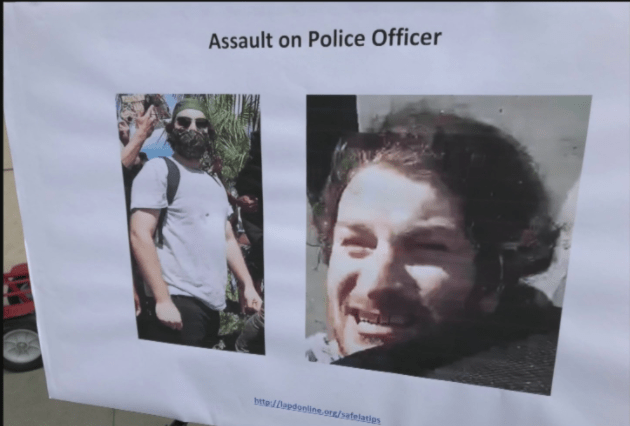Local and federal officials asked the public for information in connection with looting and other “significant crimes” in the Los Angeles area in recent weeks, when tensions between law enforcement and protesters heightened over killings committed by police officers.
According to LAPD, a task force is investigating incidents during demonstrations that began on May 29. The group consists of officials from LAPD, FBI, the L.A. Fire Department, the U.S. Attorney’s Office, the L.A. County District Attorney’s Office, the L.A. City Attorney’s Office and the police departments of Santa Monica, Beverly Hills and Torrance.
LAPD had said Chief Michel Moore was set to speak along with fire Chief Terrazas and FBI Assistant Director in Charge Paul Delacourt, but they did not appear at the news conference. Instead, police Deputy Chief Kris Pitcher, Lt. Ben Fernandes and FBI Special Agent Voviette Morgan spoke on behalf of their agencies at the LAPD’s downtown headquarters.
“Persons who committed significant crimes such as looting, burglary, robbery, vandalism, arson, and assault with great bodily injury will be held accountable for their actions,” said an LAPD statement announcing the news conference.
The task force has arrested at least five people since June 2, said Pitcher, a deputy chief with LAPD’s detective bureau.
One person, 28-year-old Gabriel Estrada, was arrested during demonstrations in downtown L.A. days after he allegedly opened fire twice at a total of four officers.
“All the officers are doing well and back at work,” said Fernandes, declining to provide further information about the case.
Another person who attacked officers remains outstanding, according to police.
The task force estimates more than 150 attacks on officers and civilians, including 139 cases of assault with a deadly weapon.
In addition, authorities reported 10 arson incidents, including the burning of an LAPD substation at The Grove, and a store and a restaurant on Melrose Avenue.
LAPD said investigators have also identified 20 looting-related crimes at multiple businesses through the city of L.A.
Police said they’re also looking for videos and tips in connection with the destruction of seven patrol vehicles.
Officials urged anyone with information to visit lapdonline.org/safelatips, which has images of people authorities are hoping to identify. Those individuals are suspected of crimes ranging from looting and robbery to arson and assault.

Morgan, the special agent in charge of the criminal division for the FBI’s L.A. field office, asked for any additional images and videos, announcing a reward of up to $10,000 for information that leads to an arrest in cases investigated by the so-called Safe L.A. Task Force.
She emphasized that the FBI respects people’s right to protest.
“Individuals should not have to have their constitutionally protected rights hijacked by individuals committing criminal activity,” Morgan said.
The news conference came amid scrutiny of authorities’ use of force against protesters demanding for justice for George Floyd, Breonna Taylor and other people of color killed by officers.
Demonstrations erupted nationwide after footage surfaced of Floyd’s May 25 death at the hands of Minneapolis police.
L.A. saw its first major protest on May 27, when hundreds of people converged in downtown, some blocking traffic on the 101 Freeway. The demonstration proceeded without incident for several hours before a small group clashed with police and smashed the window of a patrol car.
Confrontations between officers and civilians continued in downtown L.A. two nights later, when police were seen firing rubber bullets and some people began to vandalize and loot businesses. This led to officials declaring an unlawful assembly.
In the days that followed, demonstrations fanned out toward the Fairfax District, Long Beach and Santa Monica, where police in protective gear continued to clash with civilians. Protests were disrupted by instances of looting and vandalism, prompting local authorities to enforce curfews for days and call on the National Guard.
By June 7, the troops had left the L.A. area.
Protesters continue to take to the streets and attend government meetings to demand police reform, calling for policy changes and budget cuts to law enforcement.











